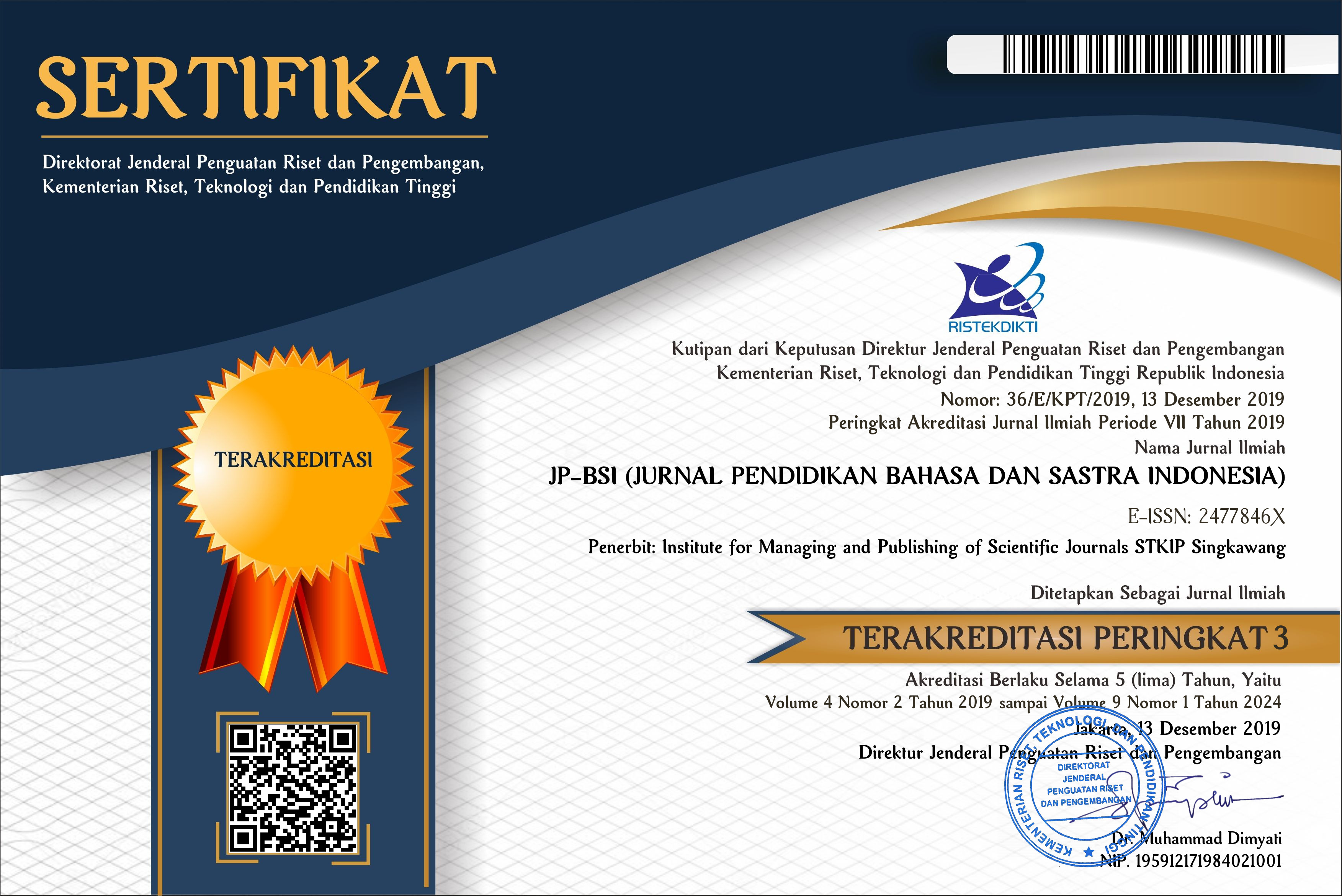A Pragmatic Study of Family-Theme Swearing Used in Compliments on Twitter
Abstract
Swearing is deemed as improper to use in certain settings. However, it can be used to convey positive emotions too, including complimenting something or someone. This research article aims to investigate the linguistic forms, pragmatic meanings, and pragmatic functions of family-theme swearing used in compliments on Twitter. Kreidler (2002), Ramlan (2005), and Ljung (2011)’s opinions were utilized in this research. Observational method was used to collect the data. Distributional and identity method were used to analyze the data. The results of this study demonstrate that: (1) linguistic forms of family-theme swearing are word and phrase, (2) the pragmatic meaning of the family-theme swearing is as utterance meaning, and (3) the pragmatic functions of the family-theme swearing are as Adjectival Intensifier and Anaphoric Use of Epithets. This research is hopefully able to assist EFL (English as a Foreign Language) students to communicate in English better with other English speakers on Twitter.
Keywords
Full Text:
PDFReferences
Adams, M. (2016). In Praise of Profanity. Oxford: Oxford University Press.
Bergen, B. K. (2016). What The F. New York: Perseus Books.
Drange, E.D., Hasund, I.G., & Stenström. (2014). Your Mum! Teenagers’ Swearing by Mother in English, Spanish, and Norwegian. International Journal of Corpus Linguistics. 19(1): 29-59.
Bastard. (2019). In Oxford Online Dictionary. Retrieved January 4, 2019, from https://en.oxforddictionaries.com/definition/bastard
Fine as wine. (2019). In Urban Dictionary. Retrieved May 27, 2019, from https://www.urbandictionary.com/define.php?term=fine%20as%20wine
Fucker. (2019). In Oxford Online Dictionary. Retrieved January 4, 2019, from https://en.oxforddictionaries.com/definition/fucker
Grosseck, G., & Holotescu, C. (2008). Can We Use Twitter in Educational Activities?, presented at 4th International Scientific Conference eLSE “eLearning and Software for Education”, Bucharest, April 17-18, 2008. https://www.researchgate.net/publication/228685205
Hughes, G. 2006. An Encyclopedia of Swearing: the Social History of Oaths, Swearing, Foul Language, and Ethnic Slurs in the English Speaking World. New York: M.E. Sharpe, Inc.
Indah, R. N. and Rifana, N. F. (2018). The Pattern of Compliments in Instagram Photo Comments. International Journal of Research Studies in Language Learning. 7(3): 57-69.
Jay, T., & Janschewitz, K. (2008). The Pragmatics of Swearing. Journal of Politeness Research. 4: 267-288.
Kreidler, C.W. (2002). Introducing English Semantics. Abingdon: Taylor & Francis e-Library.
Ljung, M. (2011). Swearing: A Cross-Cultural Linguistic Study. Hampshire: Palgrave Macmillan.
Maina, A. (2016, June 6). 20 Popular Social Media Sites Right Now. Retrieved December 14, 2018, from https://smallbiztrends.com/2016/05/popular-social-media-sites.html.
Ramlan, M. (2005). Ilmu Bahasa Indonesia: Sintaksis. Yogyakarta: CV Karyono.
Richards, J.C. & Schmidth, R. (2010). Longman Dictionary of Language Teaching and Applied Linguistics. Harlow: Longman.
Spears, R.A. (2000). Forbidden American: Essential Dictionary of Taboo American English. Illinois: National Textbook Company.
Statista. (2018). Number of Monthly Active Twitter Users Worldwide from 1st Quarter 2010 to 3rd Quarter 2018 (in Millions). Retrieved December 14, 2018 from: https://www.statista.com/statistics/282087/number-of-monthly-active-twitter-users/.
Sudaryanto. (2018). Metode dan Aneka Teknik Analisis Bahasa: Pengantar Penelitian Wahana Kebudayaan Secara Linguistis. Yogyakarta: Sanata Dharma University Press.
Wang, N. (2013). An Analysis of the Pragmatic Functions of “Swearing” in Interpersonal Talk. Griffith Working Papers in Pragmatics and Intercultural Communication. 6: 71-79.
Wang, W., Chen, L., Thirunayaran, K., & Sheth, A., P. (2014). Cursing in English on Twitter. Values & Social Norms. February 15-19, 2014. 415-427.
DOI: http://dx.doi.org/10.26737/jp-bsi.v4i2.1091
Refbacks
- There are currently no refbacks.
Published by:
Institute of Managing and Publishing of Scientific Journals STKIP Singkawang
e-ISSN: 2477-846X
p-ISSN: 2477-5932
Sekolah Tinggi Keguruan dan Ilmu Pendidikan (STKIP) Singkawang
Address : STKIP Singkawang, Jalan STKIP - Kelurahan Naram Singkawang, Kalimantan Barat, INDONESIA, 79251
No. Telp. : +62562 420 0344
No. Fax. : +62562 420 0342

Editor in Chief: [email protected] / Wa: +6281256252769
Coordinator: [email protected] / [email protected] / Wa: +6282142072788
Management Tools
JP-BSI Indexed by:
JP-BSI (Jurnal Pendidikan Bahasa dan Sastra Indonesia) is licensed under a Creative Commons Attribution-NonCommercial 4.0 International License.


















